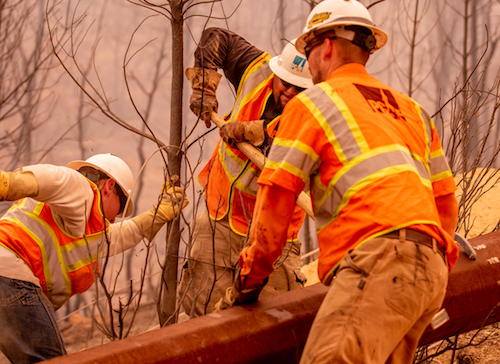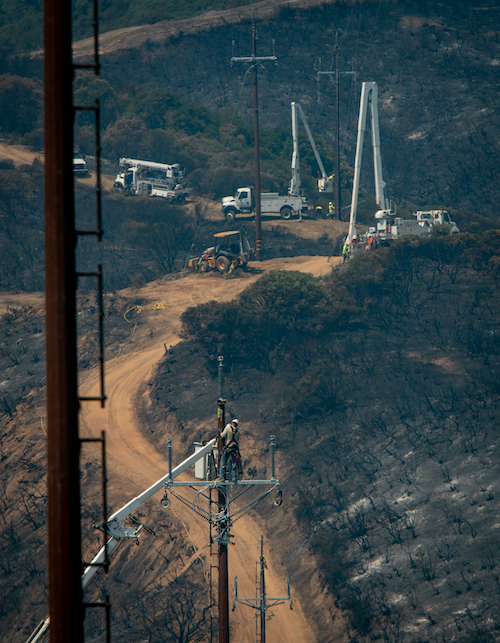As California’s brutal wildfires devour forests, destroy homes and leave thousands of people without power in suffocating heat, the welcome sight of IBEW linemen is never far behind.

|
PG&E linemen from Local 1245 repair poles in the Redding area, where the Carr fire continues to burn.
Photo by John Storey, courtesy of Local 1245.
|
Crews are ready to head inside the perimeter as soon as fire officials allow, crossing treacherous terrain to begin repairing and replacing poles and power lines while the ground is still smoking and the air gray with soot.
“Utility workers are truly the unsung heroes when it comes to fire response,” Local 1245 Business Manager Tom Dalzell said. “The fire crews rightly get a lot of credit, but the utility workers help these communities begin to literally and figuratively see the light in very dark and devastating circumstances.”
Dozens of Local 1245 members at PG&E have been dispatched to the massive Carr and Mendocino Complex fires in northern California since late July. Others volunteering for the perilous duty include members of Local 47, based in the Los Angeles area, Sacramento Local 340, San Diego Local 465 and even Seattle Local 77.
The dangers they face became all too real Aug. 4 when 21-year-old lineman Jairus (Jay) Ayeta, a popular Local 1245 apprentice, was killed in an off-road vehicle accident while making repairs in an area ravaged by the Carr fire. Off-road vehicles are commonly used in fire zones as many areas are unreachable by truck.
“We are absolutely devastated by the loss of this young life," Dalzell said. "Our thoughts and prayers are with Brother Ayeta’s family during this heartbreaking time.”
Authorities haven’t released details about the accident, but Dalzell said it underscores the danger of restoration work that is almost year-round now as California gets hotter and drier. Fires are starting earlier, spreading faster and burning longer.
“We all know that line work comes with its own risks,” he said. “That’s line work in your standard environment. These are extraordinarily hazardous conditions.”
Ayeta’s grieving brothers and sisters at Local 1245 set up a GoFundMe page for his family, remembering his smile, infectious laugh, strong work ethic, love of learning and the upbeat vibe he brought to his apprentice class.

|
PG&E crews at work in the desolate remains of the River fire, part of the Mendocino Complex fire that is now the largest forest fire in California history.
Photo by John Storey, courtesy of Local 1245.
|
“Working for a power company made me realize I made the best decision of my life,” Ayeta, a Ugandan immigrant, wrote on Facebook after getting his first job in the industry. “Every day’s something new, can’t wait to see what the future beholds.”
In the past week, as many as 20 fires at once have been raging throughout California, wind-whipped infernos that have exploded across nearly 1,500 square miles of forested land since fire season officially began in June. Experts fear the 2018 fire season could be even worse than 2017’s, the most destructive in state history.
A fire ecologist describing the scale of the Carr Fire alone told a reporter that “there aren’t enough people in the U.S. Army” to fight it. Currently, 14,000 firefighters from 17 states are battling to contain the fires; six firefighters have been killed.
Utility workers’ roles in fire recovery vary by employer. Local 340 members at signatory contractor Bullert Industrial Electric, for instance, have been bringing water treatment facilities back online so evacuated residents can return home.
About 20 Local 77 members from the Snohomish County PUD near Seattle spent a week at the Mendocino fires. “Our crews said that the best part was restoring power to folks - giving them one less thing they have to worry about,” the PUD tweeted upon the workers’ return.
Local 1245 member Chris Pearson, who works as a PG&E troubleman, is in the thick of it, scheduling jobs, assigning crews and tracking their progress from the incident command center at the Mendocino fire, now the largest fire in California’s history.
“It’s quite the large-scale operation,” Pearson said, quoted in Utility Reporter, the local’s newsletter. “Geographically, it’s such a huge span, from one side [of the fire zone] to the other. The travel distance is definitely a challenge.
“Getting access into some of these locations has been tough, because the majority of this fire has been in remote areas,” he said. “Right-of-ways and access roads have been neglected, many are impassible, and we’re doing a lot of work with heavy equipment. It’s tough out there.”
On social media, Local 1245 and Local 465 have been sharing frequent updates and extraordinary photos from the fire zones.
In one Facebook post, “Mutual Aid Day 4,” 465 Business Manager Nate Fairman salutes members from the Imperial Irrigation District, saying they “are no stranger to tough conditions, temperatures in Imperial Valley have broken records this year reaching as high as 120 degrees! Thank you for sacrificing so much time away from your families to help those in need.”
Comments are full of gratitude and prayers for IBEW members, who will be making fire repairs for the foreseeable future.
As one woman commented below a batch of Local 1245 photos, “All of this hard, hot work and you can see another fire burning behind them.”